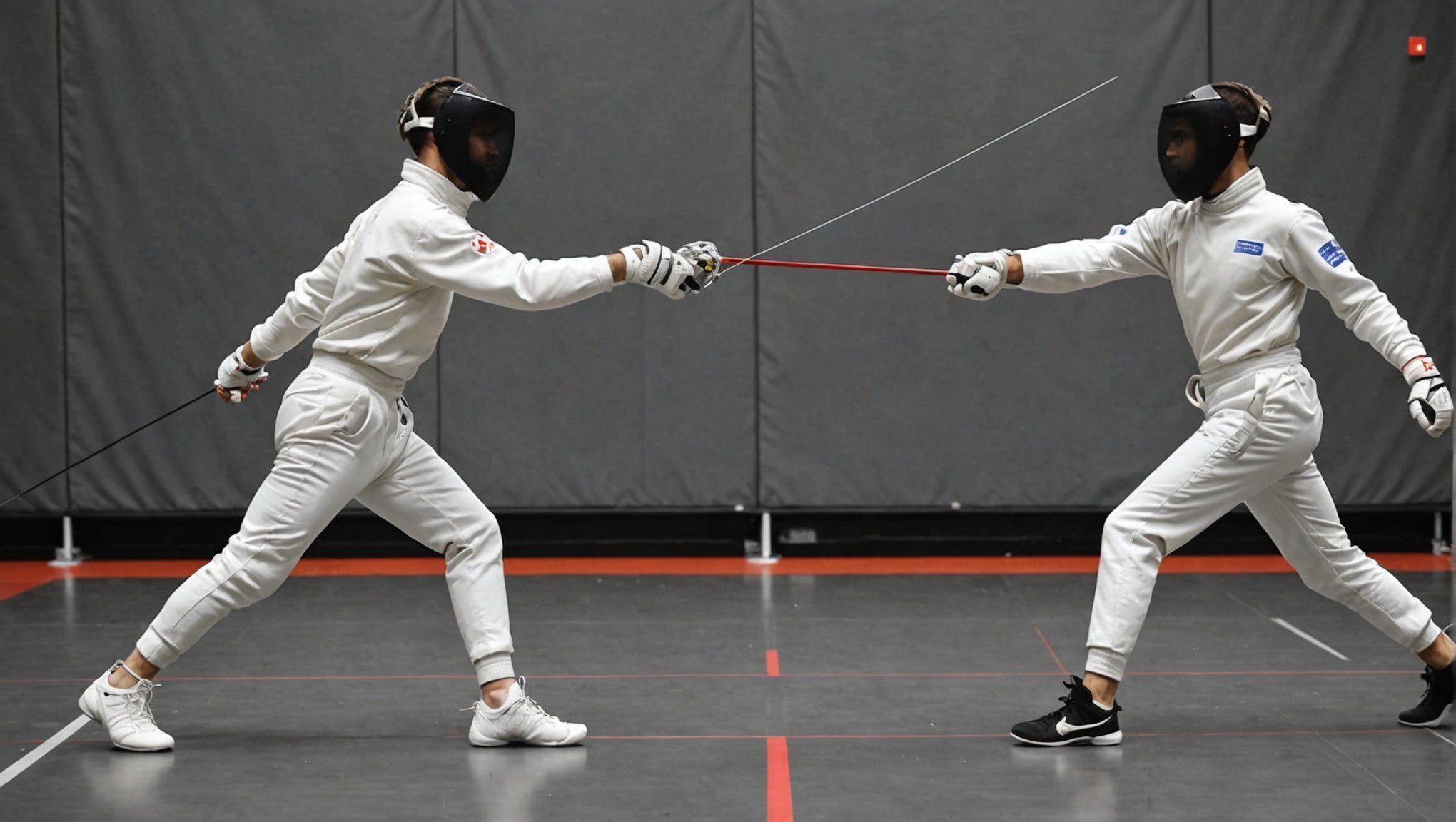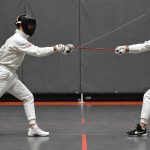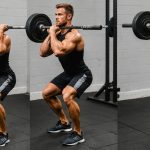Mastering Fencing Footwork: Unlocking the Secrets to Enhanced Agility and Speed
Fencing, a sport that combines elegance, strategy, and athleticism, is as much about the mind as it is about the body. At the heart of a fencer’s arsenal lies the often-overlooked yet crucial element of footwork. In this article, we will delve into the world of fencing footwork, exploring the techniques, training regimens, and practical exercises that can elevate your performance and make you a formidable opponent on the piste.
The Importance of Footwork in Fencing
Footwork is the foundation upon which all fencing skills are built. It is the key to maintaining balance, control, and the ability to execute precise movements at high speeds. As noted by UK fencing athletes, “Footwork plays a pivotal role in improving reaction times. Proper footwork ensures that an athlete can maintain balance and control while moving at high speeds.”
Also to discover : Essential Strategies for Professional Surfers to Shield Their Skin from Sun Damage in Competitions
In fencing, agility and speed are not just desirable traits; they are essential. Agility allows fencers to swiftly change direction and adapt to their opponents’ movements, while speed enables them to deliver and defend against attacks with precision. Here’s how footwork contributes to these critical aspects:
- Agility: Drills focusing on lateral movements and rapid pivots help fencers develop the agility needed to outmaneuver their opponents. Techniques such as the lunge, advance, and retreat are fundamental in training sessions, as they help fencers position themselves advantageously during bouts.
- Speed: Exercises that emphasize quick bursts of movement are crucial for developing the speed required in fencing. These include plyometric training, which involves explosive movements like jumps and bounds, to enhance muscle power and speed.
Training Regimens for Fencing Athletes
To master fencing footwork, athletes must engage in rigorous and well-structured training regimens. Here are some key components of a fencing athlete’s training:
This might interest you : Unlocking Peak Performance: Building a Deeper Connection Between Equestrian Athletes and Their Horses
Physical Conditioning
Physical conditioning is a critical aspect of fencing training. Fencers need to build strength, endurance, and agility to perform at their best. Here’s a breakdown of what this entails:
- Plyometrics and Strength Training: Incorporating plyometrics and strength training into a fencer’s routine is essential. Plyometrics enhance muscle power and speed, while strength training builds endurance and stability, crucial for maintaining form and executing precise movements during long matches.
- Interval Training: Interval training, which mimics the start/stop experience of a fencing bout, is a great complement to fencing. It involves bursts of energy combined with agility, helping fencers to improve their performance in competition.
Technical Training
Technical training is equally important and involves specific drills designed to sharpen reflexes and improve fencing techniques.
- Simulated Fencing Scenarios: Drills that simulate real match conditions help athletes anticipate and respond swiftly to their opponents’ moves. These scenarios mimic the dynamic nature of a fencing bout, allowing fencers to practice their reactions in a controlled environment.
- Private Lessons: One-on-one attention from a coach can significantly elevate a fencer’s skills. Private lessons allow coaches to catch subtle mistakes and provide focused feedback, which is particularly beneficial for adult fencers who may not have the same amount of disposable hours as youth fencers.
Practical Exercises and Drills
Enhancing footwork and reaction times in fencing requires a focused approach to drills and skill development. Here are some essential drills that can significantly improve your performance:
Essential Footwork Drills
- Mirror Drill: Pair up with a partner and mimic their movements as closely as possible. This drill enhances your ability to anticipate and react to an opponent’s actions.
- Ball Drop Drill: Have a partner drop a tennis ball from shoulder height. Your task is to catch it before it hits the ground, improving your hand-eye coordination and speed.
- Shadow Fencing: Practice fencing movements without an opponent, focusing on speed and precision. This allows for the refinement of technique and quick decision-making.
Incorporating Drills into Your Training
To see noticeable improvements, it’s crucial to integrate these drills into your routine consistently.
- Consistency is Key: Incorporate these drills into your training at least twice a week. Consistency is key in any sport, and fencing is no exception.
- Progressive Difficulty: Start with basic drills and gradually increase complexity as your skills develop.
- Feedback and Adjustment: Record your sessions or work with a coach to receive constructive feedback and make necessary adjustments.
Mental Preparation and Tactical Thinking
Fencing is as much a mental game as it is a physical one. Here’s how you can enhance your mental preparation and tactical thinking:
Reading Your Opponent
Learning to read your opponent is a critical aspect of fencing. This involves observing their movements, anticipating their actions, and strategizing your attacks accordingly.
- Observe Experienced Fencers: Watch experienced fencers and analyze their tactics. This can provide valuable insights into different strategies and techniques.
- Analyze Tactics: Observe fencing matches and analyze the tactics employed by different fencers. This helps in developing your own strategic thinking and improving your performance.
Combining Physical and Mental Training
Combining physical conditioning with mental preparation is essential for mastering fencing footwork.
- Focus on Both Aspects: Dedicate time for both physical conditioning and technical training to develop a well-rounded skill set. This ensures that you are not only physically prepared but also mentally sharp.
- Use Combat Sports Analogies: For example, in combat sports like muay thai or boxing, athletes often use jump rope as a part of their training to improve footwork and agility. Similarly, in fencing, incorporating such exercises can elevate your performance.
Practical Insights and Actionable Advice
Here are some practical insights and actionable advice to help you master fencing footwork:
Create a Training Bundle
- Athlete Bundle: Create a training bundle that includes a mix of physical conditioning, technical training, and mental preparation. For instance, you could include plyometric exercises, strength training, and specific fencing drills.
- Incorporate Variety: Ensure your training includes a variety of exercises to keep it engaging and prevent plateaus. This could include interval training, shadow fencing, and mirror drills.
Use the Right Equipment
- Speed Rope: Using a speed rope or a beaded rope can be an excellent way to improve footwork and agility. These ropes are designed for high-speed rotations, which can help enhance your foot speed and coordination.
- Heavy Rope: Incorporating heavy rope exercises into your workout can also build strength and endurance, which are crucial for maintaining form during long matches.
Stay Consistent
- Commit to Regular Training: Consistency is key in any sport. Commit to a regular training schedule, ideally 4-6 times a week, with sessions lasting between 1-3 hours. This consistent regimen allows you to build and maintain the necessary physical and mental acuity required for fencing.
Mastering fencing footwork is a journey that requires dedication, consistency, and a well-rounded approach to training. By integrating physical conditioning, technical training, and mental preparation into your regimen, you can significantly enhance your agility, speed, and overall performance.
Here is a summary of the key points to keep in mind:
- Footwork Techniques: Focus on agility and speed through drills like the lunge, advance, and retreat.
- Training Regimens: Incorporate plyometrics, strength training, and interval training into your routine.
- Practical Drills: Use mirror drills, ball drop drills, and shadow fencing to improve reaction times and technique.
- Mental Preparation: Observe experienced fencers, analyze tactics, and strategize your attacks.
- Consistency and Variety: Commit to regular training and incorporate a variety of exercises to keep your training engaging and effective.
By following these guidelines and staying committed to your training, you can unlock the secrets to enhanced agility and speed in fencing, making you a formidable opponent in the world of combat sports.
Table: Comparing Training Components
| Training Component | Description | Benefits |
|---|---|---|
| Plyometrics | Explosive movements like jumps and bounds | Enhances muscle power and speed |
| Strength Training | Building endurance and stability | Crucial for maintaining form and executing precise movements |
| Interval Training | Bursts of energy combined with agility | Mimics the start/stop experience of a fencing bout |
| Mirror Drill | Mimicking a partner’s movements | Enhances ability to anticipate and react to an opponent’s actions |
| Ball Drop Drill | Catching a tennis ball dropped from shoulder height | Improves hand-eye coordination and speed |
| Shadow Fencing | Practicing fencing movements without an opponent | Refines technique and quick decision-making |
Quotes from Experts
- “Footwork plays a pivotal role in improving reaction times. Proper footwork ensures that an athlete can maintain balance and control while moving at high speeds.”
- “Consistency is key in any sport, and fencing is no exception. Making a commitment to practicing regularly and sticking to a consistent training schedule is just what it takes.”
- “Private lessons are your best way to maximize your time if you want to really improve your fencing. There’s nothing like one-on-one attention from a coach to help you level up.”
By embracing these strategies and integrating them into your training regimen, you can elevate your fencing skills, enhance your agility and speed, and become a top performer in the world of fencing.











